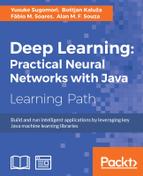Deep learning has already got higher precision than humans in the image recognition field and has been applied to quite a lot of practical applications. Similarly, in the NLP field, many models have been researched. Then, how much deep learning is utilized in other fields? Surprisingly, there are still few fields where deep learning is successfully utilized. This is because deep learning is indeed innovative compared to past algorithms and definitely lets us take a big step towards materializing AI; however, it has some problems when used for practical applications.
The first problem is that there are too many model parameters in deep learning algorithms. We didn't look in detail when you learned about the theory and implementation of algorithms, but actually deep neural networks have many hyper parameters that need to be decided compared to the past neural networks or other machine learning algorithms. This means we have to go through more trial and error to get high precision. Combinations of parameters that define a structure of neural networks, such as how many hidden layers are to be set or how many units each hidden layer should have, need lots of experiments. Also, the parameters for training and test configurations such as the learning rate need to be determined. Furthermore, peculiar parameters for each algorithm such as the corruption level in SDA and the size of kernels in CNN need additional trial and error. Thus, the great performance that deep learning provides is supported by steady parameter-tuning. However, people only look at one side of deep learning—that it can get great precision— and they tend to forget the hard process required to reach that point. Deep learning is not magic.
In addition, deep learning often fails to train and classify data from simple problems. The shape of deep neural networks is so deep and complicated that the weights can't be well optimized. In terms of optimization, data quantities are also important. This means that deep neural networks require a significant amount of time for each training. To sum up, deep learning shows its worth when:
- It solves complicated and hard problems when people have no idea what feature they can be classified as
- There is sufficient training data to properly optimize deep neural networks
Compared to applications that constantly update a model using continuously updated data, once a model is built using a large-scale dataset that doesn't change drastically, applications that use the model universally are rather well suited for deep learning.
Therefore, when you look at business fields, you can say that there are more cases where the existing machine learning can get better results than using deep learning. For example, let's assume we would like to recommend appropriate products to users in an EC. In this EC, many users buy a lot of products daily, so purchase data is largely updated daily. In this case, do you use deep learning to get high-precision classification and recommendations to increase the conversion rates of users' purchases using this data? Probably not, because using the existing machine learning algorithms such as Naive Bayes, collaborative filtering, SVM, and so on, we can get sufficient precision from a practical perspective and can update the model and calculate quicker, which is usually more appreciated. This is why deep learning is not applied much in business fields. Of course, getting higher precision is better in any field, but in reality, higher precision and the necessary calculation time are in a trade-off relationship. Although deep learning is significant in the research field, it has many hurdles yet to clear considering practical applications.
Besides, deep learning algorithms are not perfect, and they still need many improvements to their model itself. For example, RNN, as mentioned earlier, can only satisfy either how past information can be reflected to a network or how precision can be obtained, although it's contrived with techniques such as LSTM. Also, deep learning is still far from the true AI, although it's definitely a great technique compared to the past algorithms. Research on algorithms is progressing actively, but in the meantime, we need one more breakthrough to spread out and infiltrate deep learning into broader society. Maybe this is not just the problem of a model. Deep learning is suddenly booming because it is reinforced by huge developments in hardware and software. Deep learning is closely related to development of the surrounding technology.
As mentioned earlier, there are still many hurdles to clear before deep learning can be applied more practically in the real world, but this is not impossible to achieve. It isn't possible to suddenly invent AI to achieve technological singularity, but there are some fields and methods where deep learning can be applied right away. In the next section, we'll think about what kinds of industries deep learning can be utilized in. Hopefully, it will sow the seeds for new ideas in your business or research fields.
